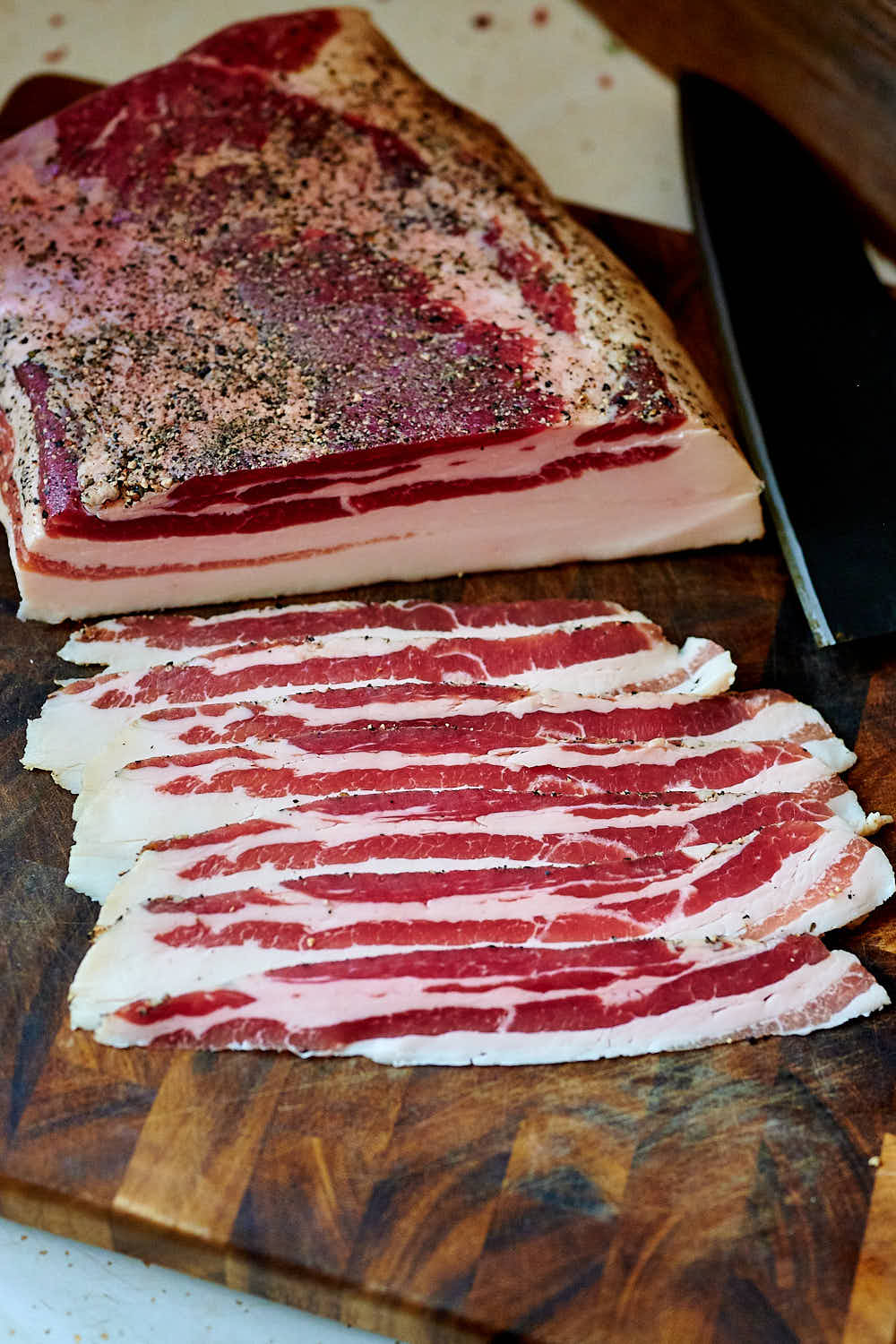I think we've all at some point in our lives wondered what cured bacon actually means and how it's differed from uncured bacon. Isn't all bacon cured? What is uncured bacon? Well, read on to find out.

The difference between cured and uncured bacon
Curing is the food preservation and flavoring process that uses salt as the curing agent. Salt curing decreases bacon's water activity, thereby making it less hospitable for the microbe growth that causes its spoilage. This doesn't make it safe to eat raw though. You can increase bacon's shelf life by drying it after curing.
Bacon curing process often involves smoking, spicing, cooking, or the addition of combinations of sugar and nitrite (found in Cure #1). Cure #2 (which contains nitrate) is not permitted for bacon curing.
When it comes to uncured bacon, you can think of it as being one of the two products: plain raw pork belly or bacon that was 'manufactured without the use of nitrite' as required by USDA Bacon Safety Regulations. USDA requires that such commercially produced bacon must be labeled "Uncured Bacon, No Nitrates or Nitrites added" and bear the statement "Not Preserved, Keep Refrigerated Below 40 °F At All Times".
But wait a second, isn't salt a curing agent itself and you don't need nitrite for curing? That's correct. However, labeling bacon cured without nitrite as 'uncured bacon' serves as a warning for consumers to treat it as raw meat that needs to be cooked and prevent them from getting sick.
The difference between salt pork and salt-cured bacon
Salt pork, also known as salt-cured pork, is pork belly, sometimes pork back fat, cured with salt and spices. Salt-cured bacon is, in fact, a kind of salt pork. Some butches sell them interchangeably. But not all salt pork is exactly like bacon. Often salt pork is much saltier and needs to be rinsed before using. Butches to make salt pork from the lowest part of pork belly, which is fattier, with less meat. Salt pork, since it contains no nitrites, is never smoked.


Dan Estridge says
In case it's of interest for readers, the reason for including nitrite in the cure for smoked bacon is that the smoking environment (having little to no oxygen) is hospitable to clostridium botulinum - the anaerobic microbe responsible for botulism poisoning and nitrite inhibits c.bot. In short, the regulatory rationale is safety.
Further, for those commercially produced 'uncured' items, though the ingredients do not include nitrite as such, in most instances the ingredients include some vegetable-based source of nitrite which is functionally equivalent.
Victor @ Taste of Artisan says
Thanks, Dan. Safety is number one. But, undeniably, nitrite cured meats have better appearance and color too. They also tend to have a longer shelf life. Good point on uncured classification - even though bacon or sausage may include naturally occurring nitrites USDA still requires to classify them as uncured. Should we call it uncured cured bacon? 😉
JoeA says
How many cases of botulism poisoning resulting from craft/home cured meat, where nitrates/nitrites were not used, have been documented by the CDC in the last year? In the last 5 years? How about 10 years? 50 Years? Do they actually, specifically require the use of these synthetic compounds? Or do they require a state that they are capable of producing? Do they specify whether same procedures apply to one curing pork from a heritage hog, raised well vs ground pork from that produced in an industrial environment, from mixed carcasses of hundreds (or thousands) of pigs? I think it's worth being specific before recommending a verified class 1 carcinogen. Is this about preventing illness or legal liability?
Victor @ Taste of Artisan says
I will respectfully disagree that sodium nitrate/nitrite is a verified carcinogen. I have not seen any respectable and conclusive studies on that. WebMD says this: Is Sodium Nitrate Safe?As of right now, there’s nothing that conclusively shows that sodium nitrates are unsafe. Besides, it's not that nitrites/nitrates may be carcinogenic, it's their oxides - nitrosamines, which are formed when exposed to high heat or high acidity. Which also come from many other places, like air. Eating cured meats made with curing salts is fine if done in moderation. Traditionally cured salami is not heated and low acidity. The risk is low. Besides, some studies showed that the effects of nitrosamines can be counteracted by eating plenty of fiber and antioxidants. We enjoy our cured meats with lots of fruits and veggies in the same meal. We also eat them in moderation.
Nitries aren't all about botulism prevention. You get better color, better flavor, longer shelf life and better appearance of the product. There is a much lower risk of contamination by pathogenic bacteria.
One last thought. Practically everything nowadays causes cancer if you read the news. The most recent thing is alcohol which apparently causes cancer if consumed in any amount. Drinking alcohol raises your risk of developing head and neck, breast, colorectal, esophageal, liver, stomach and pancreatic cancers. - says Health Canada. I can't recall where I read it, I think there was an article on CNN saying that ANY amount of alcohol is bad for you. Alcohol is a group 1 carcinogen like tobacco - says Minnesota Dept of Health.
Let me ask you, Joe, do you not enjoy some wine with your salami? Or with your cheese? I suspect that you do. Many of us do. Do you see the contradiction here? What about red meat itself? Consumption of red meat is probably carcinogenic to humans, says Cancer.org. Might as well give up on salami altogether if you are concerned about carcinogens.
I have a neighbor whom I wanted to treat to a cup of my best espresso made with home-roasted Yemeni coffee, which I am very proud of. He told me he did not drink coffee as it was bad for you, that his body is his temple. Yet, he spends hundreds of dollars on whiskey and craft beer each month. To each their own, but at least let's be objective and consistent when making those arguments.